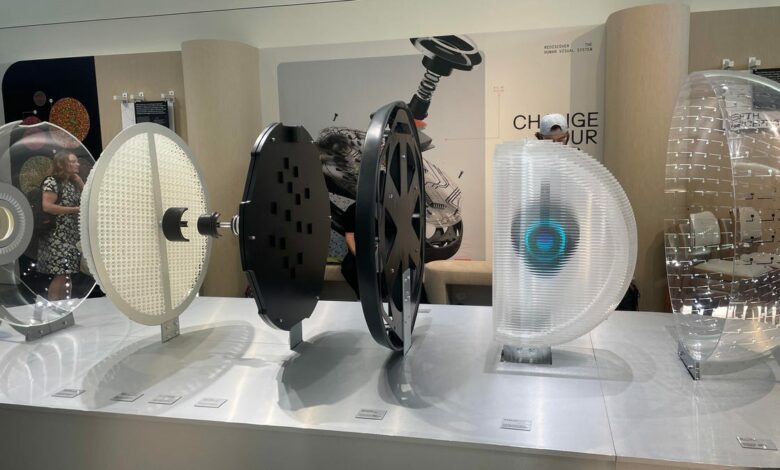A giant eyeball exhibit shows we don’t fully know what new technology will do to our vision


We talk a lot about the importance of eye health and the impact of screens and technology on vision, but we rarely compare the two directly. At the unveiling of an educational exhibit called “The Eye” on Thursday (which is exactly what it looks like — a giant prototype of a human eyeball), the American Optometric Association argued that we should treat the capabilities of our vision with as much interest as we would the latest camera or OS update.
There are similarities between the human eye and the technology we know. For example, the AOA say that the human eye has 576 megapixels, which is several times more than what you’d find on a solid smartphone camera. As another example, the lens of the eye essentially functions as a camera, focusing things; it gets harder and less flexible as we age, which is the almost inevitable age-related blurred visionAnd then there’s the link between technology use and digital eye strain, a collection of temporary symptoms caused by staring at a screen, including dry eyes, blurred vision, headaches and more.
Optometrists are using The Eye prototype to encourage people to get eye exams. However, the unveiling mainly shows that there is still much research to be done in the future into the impact of technology on vision.
Through The Eye, built to go on display in New York this weekend, the AOA also appears to be positioning the eye’s similarity to technology as a sort of tool to remind people to get an eye exam, which most people should get at least once a year. But perhaps most striking was how the giant eyeball prototype, and all the tech buzz surrounding it, also called attention to a lack of long-term research into the impact of consumer technology on vision health — at least compared to the growth of technology itself and the amount of time it demands of our eyes.
Judner Aura, a content creator for tech reviews and a panelist at The Eye unveiling, called attention to the lack of education about vision health. He said he looks forward to “more language” about vision health and consumer technology.
But for adults who spend hours on their smartphones, computers, tablets and TVs, there’s essentially no research linking technology use to long-term vision problems. Claims about eye health and screens are often speculative or designed to get you to buy something. That largely leaves it up to consumers to decide how their eyes are doing day-to-day, to keep up with routine eye exams to make sure they’re not missing an underlying health condition, and to wait patiently for more long-term information about vision health and technology.

The “pearl necklace” is a pattern an ophthalmologist can see deep within the eye during an exam that indicates a health problem. Other potentially problematic patterns, such as an onion, were also incorporated into metal displays at the AOA’s The Eye pop-up.
What is the real impact of long-term technology use on eyes? ‘Jury is still out’
There have been few things more confusing in the world of visual health than the impact of blue light on our eyes. There is currently no evidence that blue light blocking glasses offer any benefits to eye health, for example, although some people anecdotally report that they are helpful or relaxing, especially at night.
And while there is research showing the potential for permanent eye damage from exposure to blue light, the dose is much higher than what we get from technology and screens. American Macular Degeneration Foundation summarizes current thinking on blue light from technology as “conflicting and inconclusive.” While there is research that “definitively” supports wearing sunglasses to protect against the sun’s UV radiation, the same cannot be said, for example, about light from technology.
At the Eye event, optometrist and AOA panelist Dr. Belinda Starkey said research into the long-term effects of technology on eye health is still ongoing.
“It is not yet clear what happened,” she added.
Consumer tech has made some strides in the visual health space. Apple, for example, has added a touch of visual health within the bounds of available research with a setting that alerts you when your phone or tablet is too close to your face, potentially causing eye strain. It also has a feature for the Apple Watch that measures time spent in daylight, which is important for children because there is an identified link between developing eyes and time spent outdoors versus time spent indoors and the risk of myopia (nearsightedness).
The designer behind the Eye prototype, Sebastian Arrieta, has a lot of experience designing with the eye in mind. He’s worked on mixed reality headsets, including the Magic Leap. Whatever future vision or technology research brings, he points back to our advanced visual system and says we should never take our built-in technology for granted.
“We have the best technology,” Arrieta said.
If you’re in the New York City area, you can view The Eye exhibition for free at 39 Wooster St., New York, now through Sunday.




